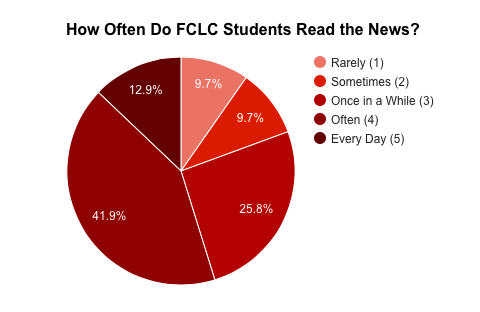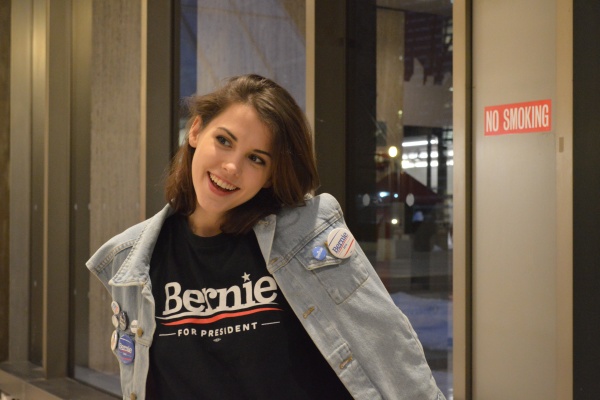News Consumption Habits of LC Students
Pictured here, Eileen Kelley, FCLC ‘17, is a supporter of Bernie Sanders’ presidential campaign. (ELIZABETH LANDRY/THE OBSERVER)
January 28, 2016
Good news! (Pun intended.) Young people are paying attention to the news. A 2014 survey by the American Press Institute (API) revealed that, contrary to popular assumption, millennials—anyone born between 1981 and 1997—are “active news consumers, with particular attentiveness to breaking news.”
The Observer conducted a survey asking respondents to rate, on a scale of one to five (five being the most often), how often they pay attention to the news. Of the responses, 12.9 percent of Fordham College at Lincoln Center (FCLC) students ages 18-22 rated their news consumption a level five, 41.9 percent rated it level four, 25.8 percent rated it level three, 9.7 percent rated it level two and another 9.7 percent rated it level one.
According to the API study, 18 to 29-year-olds are 55 percent more likely to look into the details of breaking news than they are for a week-old or longer news story.

This Millennial interest in the most recent news is perhaps relevant to the fact that in today’s “digital world,” young people are accustomed to getting new information quickly, and new news tends to be the most accessible. We can set the homepage of our Internet browsers to a site with news updates such as Yahoo; we can skim headlines while scrolling through our Twitter apps—even set preferred Twitter accounts to send tweet notifications directly to our lock screens; we can quickly access CNN, Wall Street Journal and Daily Mail highlights, among others, via the Discover feature on Snapchat. The best way to reach young people is to bring the content to them.
Kyle Kilkenny, FCLC ‘19, an avid reader of several news sources, said, “I think it’s good that there are some things that are free to access…I used to subscribe to Newsday when I was home, and then I just didn’t read it because, you know, normal high school kids just don’t have time to read newspapers.” The same could be said about college students, which is why so many access news online and through social media, where the information is typically condensed to focus on the most important details.
Research by the Pew Research Center revealed in 2013 that 45 percent of 18 to 29-year-olds consume news on Twitter and in 2015 found that 61 percent of millennials get their political news on Facebook. Think about it: Besides an aunt’s excessive posts or those delicious-looking one-minute recipe videos, what does one typically see on their Facebook feed? Video shares of current political and social issues such as gun violence, police brutality and minimum wage.
Dr. Gwenyth Jackaway, associate chair of the Department of Communication and Media Studies at FCLC, noted that a benefit regarding the spread of news and information on social media is that “people are already on social media. Many young people might not be directly connected to CNN or…Fox or [other direct news sources], but maybe someone in their network is.” Jackaway pointed out that this causes news to be spread to those who may not make a conscious effort to check the news.
“Another benefit,” she added, “is when people are passing along political news, they may add [commentary] so that fosters not only the sharing of news but the discussion of news.”
Sabrina Diamond, FCLC ’19, said, “it’s just the easiest thing—we’re already on Facebook and Twitter all the time.” She commented that news on social media can be personalized. “We can subscribe to certain people’s views…so we get it from our friends whose opinions we trust.”
Another popular site that many young people, including Diamond, use for news is BuzzFeed. “I go on BuzzFeed for a multitude of reasons. I like it for the news it makes the news really accessible and it seems like its target demographic is people my age so the language that they use and the graphics that they use…is appealing to my generation,” Diamond said.
Jackaway expressed concerns that news on social media may be limiting our exposure to views different than our own. “There’s the sad reality that people tend to flock in groups of shared political sentiment so [people are] sharing coverage of a political event that’s skewed in the direction of whatever their political orientation is and we start to live in an eco-chamber where we’re only hearing the sentiments of the people we agree with,” she said.
For those who solely rely on social media for their news, “It’s less likely for people to be getting access naturally in their social media feeds to the other side (or the other sides, because there’s not always just two),” Jackaway said.
Andrea Dixon, an adjunct professor in the Department of Communication and Media Studies at FCLC, conveyed similar sentiments. She commented that “traditional media” sources, such as NPR, the New York Times and more, tend to be the sources that “break major stories.” Social media and “niche” websites, such as BuzzFeed and Vice, “court traditional media” by “repackaging” major news stories to present them in new ways that engage young people.
Her concern lies in the fact that these sites, while tailored with characteristics that attract young people to access more information, may cause young people to lack access to multiple perspectives. “More information is meant to broaden perspectives,” she said. “It is very important that young people are educated in civic and political life.”
The expansion of news to social media and more millennial-friendly outlets encourages young people to take an interest in current events. However, this new attentiveness to news comes with the responsibility for the young adult to seek out information on all sides. A self-motivated desire to be informed will allow each of us to be stronger voters.









